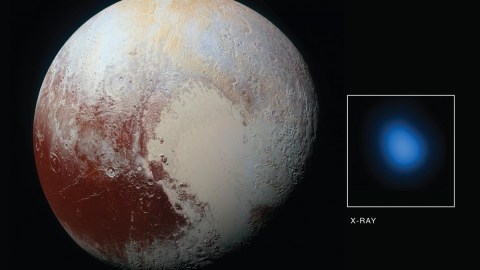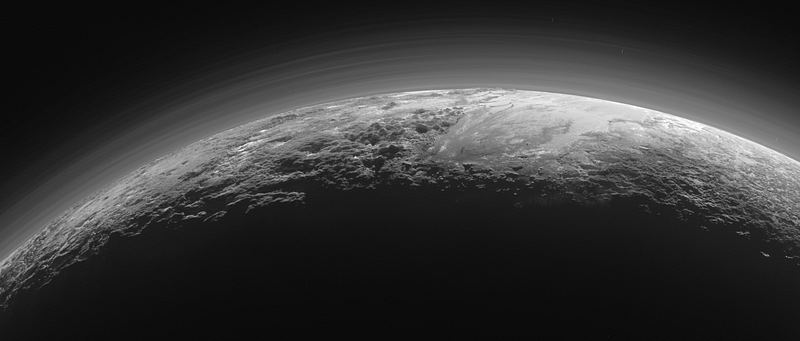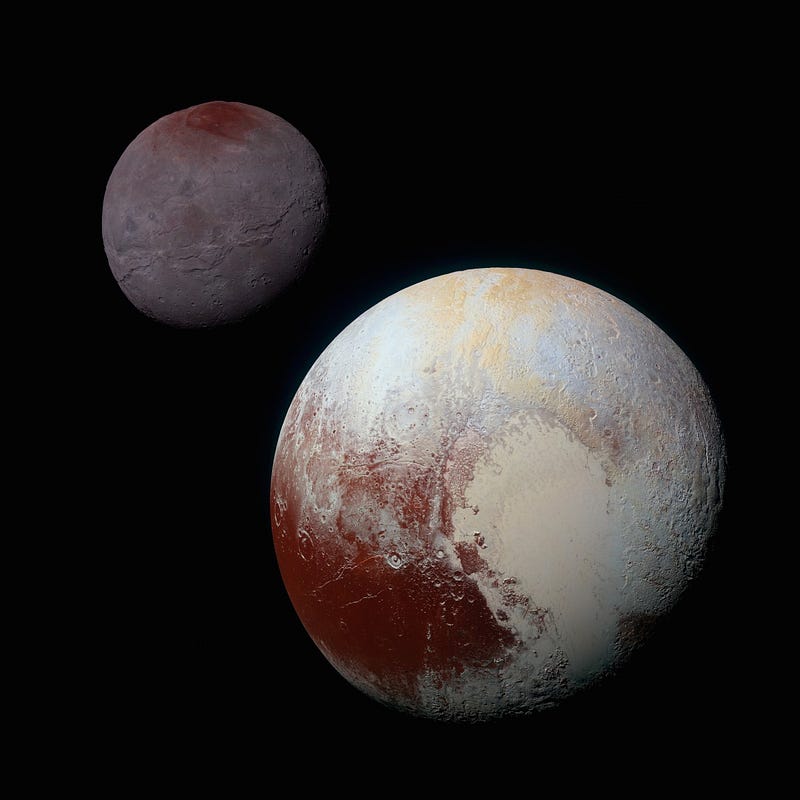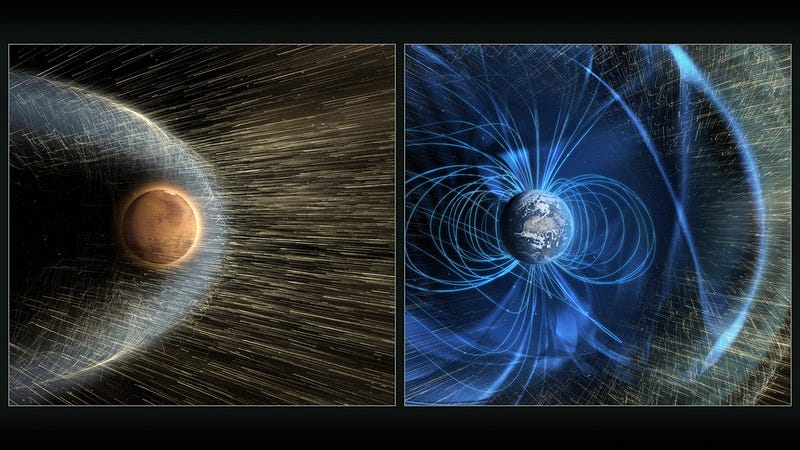That’s no comet; that’s Pluto!

Comet-like tail, X-rays and more discovered at Solar System’s edge.
“Maybe some people don’t feel scared when they think about comets and supernovas. Maybe they think it is wonderful.” –Lydia Netzer
When you think about Pluto, you likely think of a cold, frozen, distant world, floating out in the deep recesses of the Kuiper belt. That’s not far off, as NASA’s New Horizons mission showed us. This previously undiscovered world had a few surprises, including varied terrain, methane snow and icecaps, frozen nitrogen and water-ice mountains, and a hazy, dense atmosphere, all at a distance of more than 5 billion kilometers from the Sun. Its location in the Kuiper belt is also the origin of most of the comets we find in the inner Solar System, hinting that it might have some comet-like properties as well. In a new paper published today in the journal Icarus, “The puzzling detection of x-rays from Pluto by Chandra,” a team of scientists, led by Carey Lisse and Ralph McNutt of the Johns Hopkins University Applied Physics Laboratory, made the first detection of X-rays from the Kuiper belt, and found that Pluto has an enormous tail in the process.

Back when New Horizons was still on its way to Pluto, a small team of scientists led by Lisse made an ambitious proposal to Chandra: give us many hours worth of observing time to look at Pluto, even though the observatory had never been used to view a Solar System object beyond Saturn. Back in 1996, X-rays had been observed from Comet Hyakutake, which was initially a mysterious result from Germany’s ROSAT satellite. After five years of scientific detective work, it was found that highly ionized atoms — carbon, nitrogen, and oxygen with four (or more!) electrons stripped away — were being emitted by the Sun’s corona and interacting with the comet’s tail. This interaction between the ions and the escaping molecules (mostly methane, water vapor, CO2 and CO from comets) resulted in a charge exchange, ripping the electrons off of the tail’s atoms and causing the emission of X-rays. Since then, every approaching comet we’ve looked at has shown these X-rays as well. But we’ve never looked at something as distant as Pluto, until now.

After nearly 10 hours of continuously observing Pluto in February of 2014, Chandra came back with two X-ray photons instead of zero. This might not seem very convincing, but in the world of X-ray astronomy, every single photon is a major find. “Every photon is sacred and has a name,” says Lisse, and he’s only half-joking. In X-ray astronomy, these photons are so rare and high-energy that they are all incredibly meaningful. Finding more than one in a given location is a surefire sign that some interesting physics is going on. In the case of Pluto, this could mean there was an atmosphere escaping from this icy world, something that Chandra would have the opportunity to verify if they got to combine X-ray observing with New Horizons’ flyby in July of 2015.

Pluto had moved substantially in the sky over that year-and-a-half, meaning that if those two X-ray photons came from an unknown background source that happened to be aligned with Pluto, that would no longer be the case in mid-2015. At the end of July, 2015, Lisse’s team received another 39 hours of observing time, and this time Chandra detected six photons coming from Pluto. Not only that, but with a total of eight X-ray photons from Pluto, they could look at the energy spectrum in a meaningful way. The results? 100% consistent with ions from the solar wind interacting and exchanging electrons with (mostly) methane molecules that had been stripped off of the planet’s surface.

This is exactly what you’d expect if Pluto were having its atmosphere stripped away by the solar wind! Objects far beyond Neptune are so cold that they’re covered in ices; New Horizons discovered a world rich in nitrogen, methane and water ice. But Pluto has a highly elliptical orbit, and its perihelion, or closest approach to the Sun, takes it even inside the orbit of Neptune, which it achieved only a few decades ago: in 1989. The closer Pluto is to the Sun, the more the ices on its surface vaporize, forming a hazy atmosphere. That atmosphere can then be gradually stripped away by the high-energy particles of the solar wind, similar to the process that strips Mars’ atmosphere away, only on a much slower, more distant scale.

It’s the atoms in this stripped-away tail that cause the X-ray photons. “We think a similar mechanism is occurring at Pluto, even though it’s atmosphere is much more gravitationally bound than a comet’s,” according to Lisse. The tail is absolutely an essential part of this, too, since based on the amount of atmosphere that Pluto has (and the amount New Horizons saw getting stripped away) and the density of the solar wind at Pluto, we would have expected to receive only 0.2 photons, not 8!

“It likely means that Pluto significantly perturbed the solar wind, and causes it to wrap around itself and focus into a long downstream tail, where it mixes with Pluto’s escaping atmosphere and makes X-rays,” concluded Lisse and his team. While it isn’t yet known exactly what the mechanism is by which Pluto could perturb the solar wind, we have ample evidence that this is really happening. The SWAP instrument aboard New Horizons, which detects escaping gas, has found a tail more than 50 times as large as the diameter of Pluto itself.

“With our new Chandra result, we think the tail’s length is more like 1000 times Pluto’s radius! It also means we have just invented the field of Kuiper belt X-ray astronomy, and that we can expect to see X-rays from other large Kuiper Belt Objects losing atmosphere,” Lisse states, optimistically. It’s unknown whether the mechanism that focuses the solar wind onto Pluto is present around all large Kuiper belt objects, or is particular to Pluto itself. Chandra was unable to detect a distinct signal from Pluto’s moon Charon in the 49 hours of observing time, but that doesn’t necessarily mean Charon doesn’t have a tail (and X-rays) too; the separation between both worlds is only 1.7 pixels at Chandra’s distance and resolution. Perhaps future observations of Kuiper belt objects will settle the issue. Eris, the large world primarily responsible for “killing” Pluto’s planetary status, may be just what we need to take the next great leap into understanding exactly what’s happening at the Solar System’s edge!
This post first appeared at Forbes, and is brought to you ad-free by our Patreon supporters. Comment on our forum, & buy our first book: Beyond The Galaxy!





